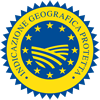Description
The Danablu PGI, also known as Danish blue, is a blue-veined soft to semi-hard, fat or full fat white paste cheese matured until it produces a blue mould.
Production Area
Danablu PGI is made throughout Denmark.
Production Method
Raw cows' milk is treated in order to standardise the fat content and to this end it is homogenised, pasteurised or heated with the addition of bacteria and other cultures to aid the growth of a blue mould. The rennet is added and, when the milk coagulates and reaches the required consistency, the curd is cut and stirred. The resulting paste is poured into moulds and left to rest so that the whey drains away. The cheese is then salted pierced and left to mature for between three and five months.
Appearance and Flavour
Danablu PGI is a light, creamy, spicy flavoured cheese with a pale, white to ivory coloured paste, a thin light straw coloured rind and with well-defined green/blue veins given by the mould, evenly distributed throughout the cheese. It is cylindrical and weighs between 2 and 3 kg.
History
Danablu PGI was first made in 1927 by Marius Boel. Since 1927, the production method has undergone some variations depending on the cheese maker. After 1930, the cheese began to be made all over Denmark and became very successful.
Gastronomy
Danablu PGI must be kept in a cold place and if it has already been cut, it should be stored in the fridge wrapped in aluminium foil. Danablu PGI can be eaten just as it is or it may be cooked. Danablu PGI is used in a variety of ways: spread on bread, cut into small pieces and added to salads or eaten with boiled potatoes. It can be gently melted, made into balls and rolled in a variety of spices such as saffron, paprika or cumin. The stronger versions are sometimes also mixed with butter. It is an excellent cheese to eat with fruit.
Marketing
This cheese is sold as Danablu PGI with varying degrees of fat content. It is sold whole or prepacked in wedges of 200 gr.
Distinctive Features
Danablu PGI cheese is well known as a Danish speciality within and beyond the European Union. It owes its reputation to legislative initiatives and also to the improvements in quality promoted and achieved over 60 years by the association of producers, who have been able to preserve the particular and traditional characteristics of this cheese and spread its fame.






